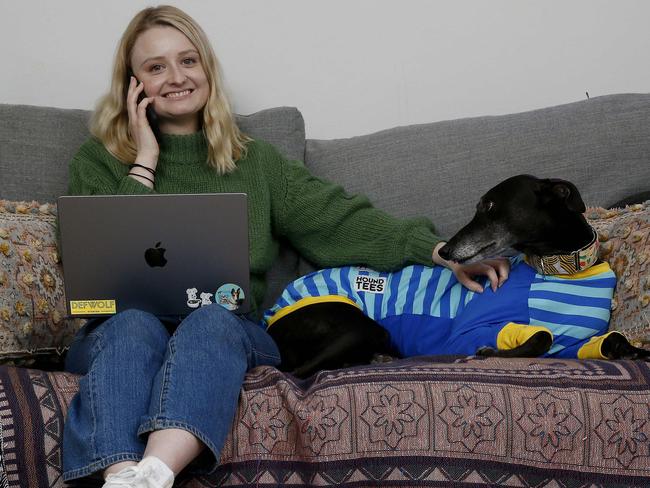Ranked: Best and worst jobs to choose if you want to work from home
New exclusive insights reveal which generations, cities and industries have returned to workplaces since the pandemic – and who is holding out. See list.
Careers
Don't miss out on the headlines from Careers. Followed categories will be added to My News.
Three years on from the declaration of a Covid-19 pandemic, the global health emergency is over and face masks have all but disappeared – but remote work remains.
New exclusive research reveals more than half of employed Australians now work from home at least some of the time, with fully remote work almost twice as common as pre-pandemic, and there has been an eight-fold increase in job ads that highlight flexible work arrangements.
Experts say the trend is not going anywhere, although employers will be negotiating specific expectations with staff for a while yet.
THE NEW NORMAL
A survey of more than 2300 Aussie adult workers by Lonergan Research found 47 per cent had now fully returned to the workplace, typically spending their entire week on site.
However, 7 per cent were now fully remote – almost double the rate before the pandemic (4 per cent).
Most were somewhere in between, with 15 per cent of full-time workers now doing two days from home in a typical week.

Recruitment specialist Hays’ chief executive Asia Pacific Matthew Dickason said remote and hybrid work trends were here to stay but he expected a lot of back and forth over the next two years as organisations and employees agreed on the preferred number of on-site days.
“Very few (employers) have called staff back into the office full time – if they did, there would be a resulting increase in turnover,” he said.
Most Australians agreed that Australia had found its new normal.
Almost half (43 per cent) of survey respondents with the ability to work from home did not expect any changes to their current arrangement, according to the Lonergan figures.
Only 11 per cent expected to eventually go back to full-time on-site work.
THE GENERATIONAL DIVIDE
Millennials aged 25 to 39 were most likely to have a remote or hybrid work arrangement (58 per cent) while Baby Boomers aged 60-plus were least likely (38 per cent).
This may be partly due to older workers typically holding more senior roles with supervisory responsibilities, but Mr Dickason said Millennials also had changing attitudes towards work-life balance.
“This is certainly a generation that values flexibility in their careers and a greater integration of personal and professional life, which hybrid working allows,” he said.
Only half of Generation Z workers aged 18 to 24 had a remote or hybrid arrangement, which may be attributed to their over-representation in customer-facing roles.
THE INDUSTRY DIVIDE
Across the board, SEEK data revealed 10.4 per cent of job advertisements on the employment portal in March contained keywords relating to working from home, such as “WFH”, “remote work”, “hybrid work” and “flexible location”.
This was about eight times more than in March, 2019 (1.3 per cent), before the pandemic.
Rates were highest in insurance and superannuation, with remote work mentioned in 40.7 per cent of job ads nationally.
It was followed by consulting and strategy (33.7 per cent), information and communication technology (29.7 per cent), marketing and communications (26.3 per cent) and human resources and recruitment (26.1 per cent).
At the other end of the spectrum were trades and services, hospitality and tourism, retail and consumer products, sports and recreation, and manufacturing, transport and logistics.
SEEK sales and service director Stephen Tuffley said there had been “plenty of discussion about reducing work-from-home hours” but this had not yet translated into the data.
“The option to work flexibly remains highly desirable for many Australians – it is the number one keyword searched on site,” he said.

THE CITY DIVIDE
Areas with a higher proportion of white-collar roles recorded higher instances of flexible work.
The Lonergan research showed 58 per cent of capital city workers now worked from home for at least a portion of their week, compared to 45 per cent of regional counterparts.
Rates were highest in Greater Melbourne (66 per cent) and Greater Sydney (62 per cent).
In Melbourne’s inner east specifically, this jumped to 80 per cent.
The research also confirmed that Friday had become the WFH day of choice.
Just 44 per cent of workers were now typically on site on a Friday, compared to 62 per cent on a Tuesday or Wednesday.
Only about a third of workers with the option to work from home turned up on a typical Friday in Greater Melbourne (34 per cent), Tasmania (34 per cent) and the ACT (36 per cent).
Workplaces reached about half capacity, however, in Sydney (45 per cent), Brisbane (47 per cent), Perth (51 per cent) and Adelaide (53 per cent).
Victorian Chamber of Commerce and Industry chief executive Paul Guerra said reduced foot traffic in the Melbourne CBD was having continuing impacts on retail and hospitality businesses.
He said trends were less pronounced in suburban and regional areas, suggesting accessibility was the key to encouraging workers back into offices.
“The CBD needs to turn its attention to how easy it is to get into the office by public transport or car or walking,” he said.
“If we can improve accessibility, we will see an organic move back to the workplace three or four or five days a week because people will want to not just work there but socialise as well.”

Business NSW executive director David Harding said Sydney businesses that relied on a “nine-to-five, professional services office workers” customer base had needed to adjust, but weekend crowds had returned to the city.
“People are using the city in a different way … we are seeing older people, families, younger people,” he said.
“We are starting to see food and beverage, experiential activities and night-life come roaring back.
“Change always has winners and losers but we are starting to settle into a realisation that overall Sydney is winning.”
THE HYBRID DRAWCARD
Sydney cybersecurity sales specialist Yvette Vials, 29, goes into the Cisco office one or two days a week, depending on her personal and professional schedules.
“The flexible working policy is a major drawcard for me, as I currently live by myself with my Greyhound, Dolores,” she said.
“I never leave her for more than eight hours, as I live in an apartment.
“Flexible working allows me to arrange care for her, if needed, for days where I need to be out.”

The cost saving associated with remote work was also a factor Ms Vials considered.
“If I work from home, I likely save approximately $25 a day on travel and food,” she said.
“The other major factor for me is the commute which is around 1 hour 15 minutes each way.”
Cisco’s 2022 Hybrid Work Study found 84 per cent of workers saved money by working from home, with an average of $216 saved weekly.
Cisco vice president for Australia and New Zealand Ben Dawson said offices still had a role to play – particularly if technology was better in the workplace than at home and for roles that required human connection – but he preferred to think of the office as a magnet rather than mandate.
“Flexible working shouldn’t be seen as a ‘work perk’ but a prerequisite for businesses, otherwise they are going to miss out on attracting and retaining the best talent – and with skills shortages still affecting several industries, it’s worth taking it seriously,” he said.
More Coverage
Originally published as Ranked: Best and worst jobs to choose if you want to work from home




